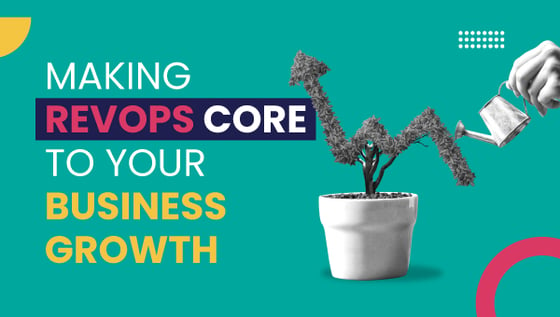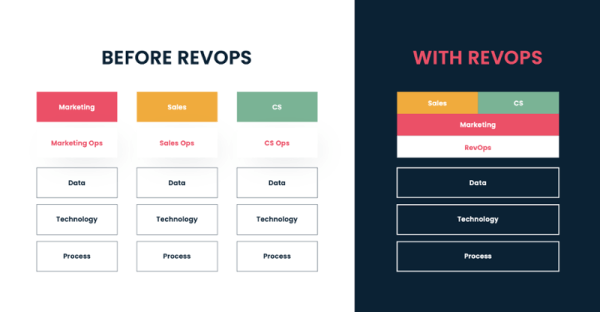






In today's competitive business landscape, companies are seeking new ways to optimise their revenue growth strategies. One emerging concept that has been gaining popularity over the last few years is Revenue Operations, or RevOps for short. RevOps is a holistic approach to managing revenue growth by aligning sales, marketing, and customer success in a cohesive and collaborative manner. In this article, we will explore the importance of RevOps, its key components, and how to develop a data-driven RevOps strategy to drive your business growth.
Understanding the Importance of RevOps
Revenue Operations is not just another marketing buzzword. Rather, it is a strategic initiative that is increasingly being seen as critical to a company's sustained growth.
In the past, sales, marketing, and customer success teams operated in silos, with little communication and collaboration between them. However, in today's digital age, customers demand a seamless and personalised experience across all touch points.
This is where RevOps comes in - by breaking down silos and aligning these three functions towards a common goal of revenue growth, companies can deliver a more cohesive customer experience, increase retention rates, and ultimately drive business growth.

Defining Revenue Operations (RevOps)
RevOps is an operational framework that brings together the key revenue-generating functions of an organisation - sales, marketing, and customer success - to drive business growth. At its core, RevOps is about creating a seamless, end-to-end customer experience that aligns sales, marketing, and customer success towards a common goal.
The Connection between RevOps and Business Growth
The ultimate goal of any business is to grow its revenue. RevOps enables this growth by providing a holistic view of the customer journey, from lead generation to customer retention. By aligning sales, marketing, and customer success around a unified strategy, companies can optimise their revenue growth initiatives to drive higher customer lifetime value and business growth.
Key Components of a Successful RevOps Strategy
Successful RevOps strategies are built on three key components - people, processes, and technology. Firstly, people - it is critical to have a collaborative culture that is customer-centric and focused on revenue growth. Secondly, processes - there must be well-defined processes that enable sales, marketing, and customer success teams to work together effectively. Thirdly, technology - deploying the right technology stack is critical to support the processes and enable data-driven decision-making.
Building a Solid RevOps Foundation
Any successful RevOps program starts with building a solid foundation. This involves aligning sales, marketing, and customer success teams towards a common goal, and implementing processes that support collaboration and effective decision making.
Revenue Operations (RevOps) is a holistic approach to managing the revenue-generating functions of an organization. It involves breaking down silos between sales, marketing, and customer success teams and creating a unified revenue team that works towards a common goal.
Aligning Sales, Marketing, and Customer Success Teams
The key to successful RevOps is alignment between sales, marketing, and customer success teams. This means that all three functions should be aligned towards a common goal of revenue growth, and work collaboratively towards achieving this goal. Collaboration should be built around the customer journey, ensuring that there is consistency of messaging and experience across all touchpoints.
Alignment between sales, marketing, and customer success teams is not just about working together towards a common goal. It is also about breaking down silos and creating a culture of collaboration and transparency. This means that teams should be encouraged to share data and insights, and work together to improve the customer experience.
Effective alignment between teams requires a clear understanding of each team's role in the revenue process. Sales teams are responsible for generating revenue by closing deals, while marketing teams are responsible for generating leads and creating brand awareness. Customer success teams are responsible for ensuring that customers are satisfied and renew their contracts. By understanding each team's role, it becomes easier to align them towards a common goal.
Implementing Effective RevOps Processes
Effective processes are critical to the success of any RevOps program. This includes lead generation, qualification, and management processes, as well as sales and customer success processes. Processes should be well-defined and documented, with clear accountability and metrics in place. This enables data-driven decision-making, and ensures that teams are working towards the same objectives.
Effective RevOps processes should be designed with the customer in mind. This means that processes should be designed to create a seamless customer experience, from the first touchpoint to the final sale. Processes should also be designed to be flexible and adaptable, to accommodate changes in the market or customer behavior.
Effective RevOps processes should also be designed to be scalable. This means that processes should be able to accommodate growth in the organization, without becoming inefficient or cumbersome. Scalable processes enable organizations to grow and evolve, without sacrificing efficiency or customer experience.
Leveraging Technology and Automation in RevOps
Technology is key to enabling data-driven decision-making and automating repetitive tasks. It is important to choose the right technology stack that supports the RevOps processes and enables seamless collaboration between teams. This includes CRM, marketing automation, sales enablement, and customer success tools.
Choosing the right technology stack is not just about selecting the right tools. It is also about ensuring that the tools are integrated and work seamlessly together. This requires a deep understanding of each tool's capabilities and limitations, as well as the ability to customize and configure the tools to meet the organization's specific needs.
Automation is also an important aspect of RevOps. By automating repetitive tasks, teams can focus on more strategic activities that drive revenue growth. Automation can also improve efficiency and reduce errors, leading to a better customer experience.
In conclusion, building a solid RevOps foundation requires alignment between sales, marketing, and customer success teams, effective processes, and the right technology stack. By focusing on these key areas, organisations can create a unified revenue team that drives revenue growth and creates a seamless customer experience.
Developing a Data-Driven RevOps Strategy
A key advantage of RevOps is its ability to leverage data to make informed decisions that drive business growth. A data-driven RevOps strategy involves establishing KPIs, analyzing and interpreting RevOps data, and making data-driven decisions for continuous improvement.
RevOps is an essential component of any modern business, and a data-driven strategy is crucial to its success. By using data to drive decision-making, businesses can optimize their revenue operations for maximum efficiency and growth.
Establishing Key Performance Indicators (KPIs)
KPIs are critical to measuring and optimising RevOps performance. Key metrics include lead generation, conversion rates, customer acquisition cost (CAC), customer lifetime value (CLTV), and retention rates. These metrics provide a comprehensive view of the entire customer journey, from initial lead generation to long-term customer retention.
Establishing KPIs should be a collaborative effort across all three functions of RevOps: sales, marketing, and customer success. By working together to establish KPIs, businesses can ensure that all teams are aligned and working towards the same goals.
Once KPIs are established, they should be regularly tracked and analyzed for continuous improvement. This involves monitoring performance against targets and identifying areas for improvement.
Analysing and Interpreting RevOps Data
RevOps data is typically abundant and diverse, coming from a variety of sources such as CRM, marketing automation, and customer success tools. To derive insights from this data, it is important to have the right tools and skills to analyse and interpret the data in one connected platform.
Data visualisation tools, such as dashboards and reports, can help to make sense of complex data sets. Data analytics skills, such as statistical analysis and data modeling, are also essential for interpreting RevOps data.
However, having the right tools and skills is only part of the equation. A data-driven mindset is also crucial for making the most of RevOps data. This involves a willingness to question assumptions, challenge conventional wisdom, and use data to drive decision-making.
Making Data-Driven Decisions for Continuous Improvement
The key to driving continuous improvement is to use RevOps data to make data-driven decisions. This involves identifying areas for improvement and implementing changes based on these insights.
Continuous improvement should be a collaborative effort across all three functions of RevOps. By working together to identify areas for improvement, businesses can ensure that all teams are aligned and working towards the same goals.
Ultimately, a data-driven RevOps strategy is essential for optimizing revenue operations and driving business growth. By establishing KPIs, analysing and interpreting RevOps data, and making data-driven decisions for continuous improvement, businesses can stay ahead of the competition and achieve long-term success.
Overcoming Common RevOps Challenges
While RevOps is gaining traction as a critical initiative for revenue growth, there are still common challenges that companies face when implementing RevOps strategies. These challenges include breaking down silos between departments, ensuring consistent communication and collaboration, and adapting to changing market conditions and customer needs.
Breaking Down Silos between Departments
Silos between departments can undermine the effectiveness of RevOps initiatives. Breaking down these silos requires a culture of collaboration and communication, as well as well-defined processes that enable cross-functional teamwork.
One way to break down silos between departments is to create a shared understanding of goals and objectives. When everyone is working towards the same goal, it becomes easier to collaborate and communicate effectively. This can be achieved through regular meetings and joint planning sessions where all stakeholders can contribute their ideas and perspectives. By creating a culture of open communication, companies can break down silos and foster a more collaborative environment.
Ensuring Consistent Communication and Collaboration
Effective RevOps requires consistent communication and collaboration between sales, marketing, and customer success teams. This involves regular meetings, joint planning sessions, and well-defined communication channels that support seamless collaboration.
One way to ensure consistent communication and collaboration is to establish clear roles and responsibilities for each team. This can help to avoid overlap and ensure that everyone is working towards the same goals. Additionally, companies can leverage technology solutions such as collaboration software and project management tools to facilitate communication and collaboration between teams.
Adapting to Changing Market Conditions and Customer Needs
RevOps strategies must be flexible and adaptable to changing market conditions and customer needs. This requires a willingness to adapt processes, technology and strategies based on data-driven insights, and the ability to pivot quickly when needed.
One way to adapt to changing market conditions and customer needs is to regularly collect and analyze customer feedback. This can help companies to identify areas for improvement and make necessary changes to their RevOps strategies. Additionally, companies can leverage data analytics tools to gain insights into market trends and customer behavior, allowing them to make data-driven decisions and pivot quickly when needed.
In conclusion, while implementing RevOps strategies can be challenging, companies can overcome these challenges by breaking down silos between departments, ensuring consistent communication and collaboration, and adapting to changing market conditions and customer needs. By fostering a culture of collaboration and leveraging technology solutions and data-driven insights, companies can successfully implement RevOps strategies and drive revenue growth.
Conclusion
RevOps is a holistic approach to managing revenue growth that aligns sales, marketing, and customer success towards a common goal. A successful RevOps strategy requires a well-defined foundation, data-driven decision-making, and a willingness to adapt to changing market conditions. By overcoming common challenges and implementing a data-driven RevOps strategy, companies can optimize their revenue growth initiatives to drive business growth and improve customer engagement.








